#Dreyse needle rifle
Explore tagged Tumblr posts
Text


4th Garde-Grenadier-Regiment Königin Augusta, 1870
35 notes
·
View notes
Text
Paris-Commune-Related Work for Commune Week 2023

Léon Choubrac, Le Dernier Jour de la Commune (1883).
Seeing that my post from last year (thank you, @paperandsong) has gained a little attention, I am compiling the works I have written to commemorate the Paris Commune in this post. These are not explicitly POTO-related, but no knowledge of the fandom I'm writing in is required to read them. The franchise (Senjyuushi) personifies various firearms, and I write about historical firearms related to the Franco-German War and the Commune during the Commune. The franchise does not deal with this context, and all the firearms I write about are original characters. If you're interested in the historical context of the Commune, or learning various facts about it, you can read my Madder Skies series:
Une fête cerise - The Commune as witnessed by a Tabatière rifle. (He is affectionately named Ignace for his fiery nature.) Themes: women of the Commune, disillusion, hope. A lot of unsaid affection.
Allons enfants de la patrie - The Commune from the eyes of a Chassepot rifle named Florence, owned by a child Communard. Themes: children, war horrors, innocence, bathos, propaganda. Erik makes a cameo! The second chapter contains historical notes on the Commune.
Beyond Madder Skies - The centrepiece of the series. A Chassepot rifle from the Versailles army finds himself stranded behind German forces that are observing the repression of the Commune. He acquaints himself with a Dreyse needle rifle (from Prussia), and they re-negotiate their relationship as enemies as the Chassepot fights to return to his comrades. Each chapter covers a day in the final week of the Commune.
I would love to put out new work related to the Commune, POTO, or Madder Skies this year, hopefully before Commune Week ends. Stay tuned...
9 notes
·
View notes
Text
A more interesting one:
75 years before 1911 was 1836. That was the same year that Samuel Colt got the patent of his 'revolving gun', US patent number 138.
The first gun he made in 1836 was the Colt Paterson:

And for long arms, we got across the Pond to Britain for the Brunswick Rifle:

And then to Germany, where the Dreyse needle gun (Zündnadelgewehr) is being invented:


476 notes
·
View notes
Text
April 18 – Day of the Battle of Dubbel in Denmark

A painting by Jergen Sonne. "The Battle of Dubbel". (1871)
Sometimes the mind does not understand Europe. Estonians celebrate the day of the Danish flag, because of which they fell from the sky, lost the Battle of Lindanis in 1219. And the Danes, in turn, celebrate the battle during which they were defeated by the Prussians.
After the annexation of Schleswig in November 1863 by Danish King Christian IX (who was also Duke of Schleswig), Prussian-Austrian troops invaded Jutland in January 1864.
The Danish army was equipped worse than the German troops and had old rifles. The Prussian army was equipped with Dreyse needle guns, which could be reloaded lying down, whereas the Danes had to reload their rifles standing up, and therefore were a good target for the Prussians.
Fort Dubbel is located on a short peninsula that protects from access to the fort from land. The unfortunate geographical location and terrain eventually made this place completely unsuitable for long-term defense.The Danes had only one major advantage - they dominated the sea. By the time the battle began, they were able to moor the newest twin-towed battleship Rolf Krake off the coast to support the Danish ground forces with the help of shore bombing. However, the firepower of the Rolf Krake was not used to the proper extent.

On the morning of April 18, 1864, the Prussians stormed. And soon they won. During the battle, only about 3,600 Danes and about 1,200 Prussians were killed, wounded or missing.
In honor of this defeat, the national flag is raised in Denmark on April 18 and celebrations are held.
Read more in the post "Day of the Battle of Dubbel"
*Translated using an electronic dictionary. The original text in Russian and much more on the criminal topic can be selected on the main page of the site - http://crimerecords.info/
1 note
·
View note
Text
youtube
Dreyse and Chassepot --- Needle fire rifles of the Franco-Prussian War
from cap and ball channel
36 notes
·
View notes
Photo


Breech Loading Rifles from the Second Schleswig War dated around 1865 on display at the National Museum of Denmark in Copenhagen
The weapon on the left is Dreyse Needle Gun used by the Prussian forces during the Second Schleswig War with Denmark. The rifle gave the Prussians a significant advantage over the Danish forces as it could be reloaded from the breech allowing a faster rate of fire and from behind cover. The Danish army used muzzle loading rifles during the war, as did many other armies in Europe and America, which were difficult to load behind cover and so the soldiers had to stand making them easy targets.
The weapon on the right is a Snider Converted Danish Breech Loading Rifle with bayonet which was not used during the war. However after the conflict many of the muzzle loading rifles, which were used in the war, were converted using the Snider system before the development of proper breech loaders, such as this one here. This was common in many armies as it saved money converting existing rifles rather than buying new ones.
Photographs taken by myself 2018
#military history#19th century#victorian#prussian#denmark#danish#schleswig war#national museum of denmark#copenhagen#barbucomedie
32 notes
·
View notes
Note
What's more aesthetically pleasing? A bolt gun or a breechloader? And for whichever you pick, what kind, if you could have any one you wanted, would you want?
To be fair, that’s quite a hard question.
A lot of breechloading rifles come just after the musket era, so there’s a lot of old design ideas recycled, like the Snider-Enfield. The carbine version of that is a weird gun. The Dreyse needle gun, a gun that is technically both a breech loader AND a bolt action rifle, is another good example.
The Martini-Henry is a aesthetically pleasing breechloader. But I do find bolt action rifles the more aesthetically pleasing. Just because there’s something about the action of drawing the bolt back, letting the spent cartridge fly out before you close the bolt... it’s just really nice. Really nice.
For wanting a bolt action rifle... it’s kind of a no-brainer.

The Short-Magazine Lee Enfield No.4 Mk.1. Or the Mk.2.
38 notes
·
View notes
Text
Day Thirty-Four: The Hot Zone
https://aroundtheworldinsearchofcokev.blogspot.com/2019/07/day-thirty-four-hot-zone.html
War and Peace is a decidedly large military vehicle and re-enactment show near Paddock Wood in Kent, and it was the site of our last hurrah for the trip. When I booked tickets, it was about twenty degrees in the heat of the day and didn’t seem likely to change. However it seemed today the weather wanted to get into the living history spirit by re-enacting Vietnam.
Thirty-two Celsius shouldn’t seem hot to an Australian, but it was a strange, oppressive and humid heat that beat down on Kent today, a kind I hadn’t felt in a long, long time. This is not to say I didn’t have fun – I did – but by twelve we were all at the end of what we could endure, and thus left for Bedford.
That having been said, what did I see today? Many of the reenactors were gathered in shady areas with the bare minimum of kit – I cannot for the life of me blame them. This however had a strange upside, for at War and Peace there were a number of WWII North Africa and Vietnam War reenactors, and the heat was basically authentic for what they were portraying, which meant that their often rag-tag and sweaty appearance was actually fairly true to what real soldiers on those fronts wore. Men were stripped down to flak vests and helmets; khaki drill was unbuttoned, and faces were red. Therefore, I spent most of my time among them, and I think I got some very nice pictures.
That having been said, my heart goes out to the guys dressed in full Home Guard and Royal Air Force home service kit, who, being a headline feature of the event, couldn’t really get away with stripping down, and gamely soldiered on in full cotton battledress. Also, a shoot-out to the guy I saw in the full three-piece suit – I can’t tell if you’re brave or insane.
I bought a book in the stalls and looked at some of the bewildering (some might say worrying) variety of deactivated and replica firearms there. Don’t worry, they’re just historical pieces, they can’t be made to fire again. I got to hold a full ‘gangster-style’ Thompson gun, an AK-47 and an Italian Carcano rifle, and I think feeling the weight and ergonomics of the weapons does help us understand how they were used and what soldiers thought of them. I also briefly handled a Prussian Dreyse ‘needle-gun,’ one of the first semi-practical breech-loading weapons, and I was startled by how heavy and cumbersome it was. The gun weighs 10.4lbs, is over a metre long, and was only really effective up to six hundred yards – hardly the world-beater it’s often portrayed as. Yet the Dreyse basically pioneered the way rifles would work for a hundred years. I suppose it’s interesting to think that such a clumsy piece of kit would change so much.
In any case, it was time to set off for home. Save for congestion on the junction between the M25 and the A1, it was surprisingly easy, and we hunkered down out of the heat for the rest of the day.
Tomorrow is our last full day in Great Britain. How time flies…
1 note
·
View note
Note
Could you make a brief text post that's a chronological list of all Swiss standard infantry rifles starting from wherever you think the history should start to the present? If it's not too much trouble.
Of course. But first of all a caveat : I’m mostly interested in post-WW1 guns, so my knowledge of antique guns is at best superficial. That is why it took me a little bit of time to answer you, I had to do some researches. So I speak under the control of our resident gun historian, @peashooter85 and my friend @shmurnoff that are way more better equipped for that kind of era.
The modern Confederation begins in 1848, so that would be our cutline.
Before that, you have the classical percussion rifle in service in the various Cantonal armies, like in Zürich with this 1830 18mm Stutzer :

or we get this Federal Francotte 1842 in 18mm :
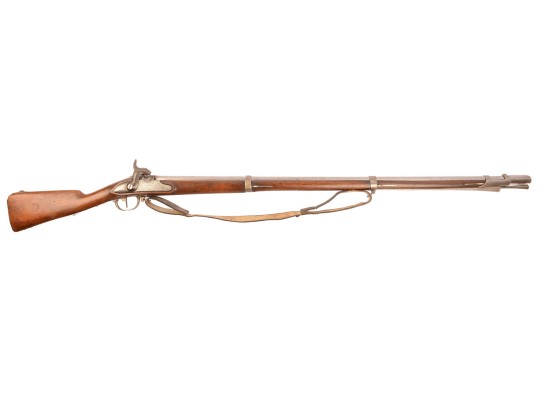
Since the story is a bit long, click after to jump to read it :
But after the 1847 civil war, the all-new Confederation decide to lay the foundations of being state-of-the-art in term of infantry light weapons, and it will be the tradition of Swiss Army for the next 150 years at least.
They adopt the very ugly 1851 Federal rifle. What make it a modern gun ? It’s the first military rifle to get rid of the 18mm caliber to go down to the lightest and fastest 10.5mm ball. The 10.5mm will gradually became a 10.4mm, a diameter that will stay in service until the introduction of the Schmidt-Rubin rifles and the GP90 7.5mm cartridge.

In 1859, comes one step backward with the Prélaz-Burnand, aka the first SIG rifle. It’s a transformation of old 1842 rifles with better sights and a rifled barrel and was officialiy adopted in 1863.


It may seems a strange move, but these upgraded rifles cost alsmot 20x times less than buying new rifles and they were available in a few months instead of a few years for the 1851 model.
In 1856 came the Belgian Hunters Rifle. Even if with its rifled barrel it was quite trendy, by the time it was issued (1860), it was already obsolete.

Like its predecessor, the 1851 rifle, it went through the Milbank-Amsler upgrade, with a breech loading system à tabatière using metallic cartridges.
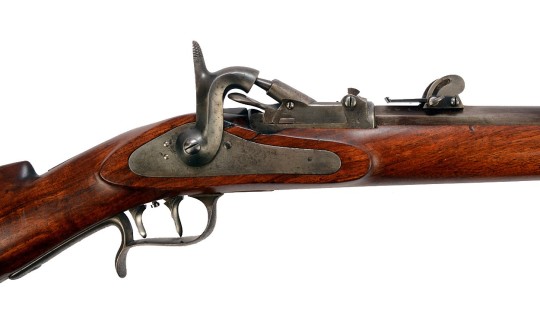

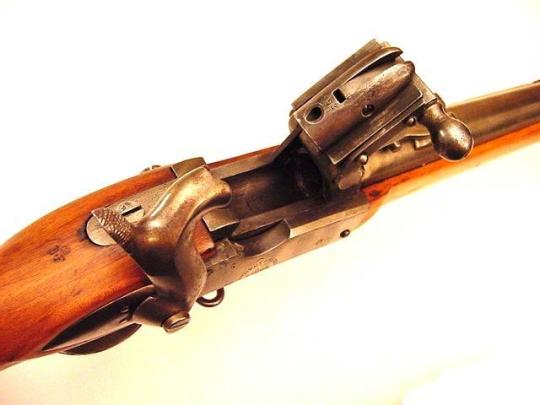
That upgrade was also used on old 1842 and 1842/59 Prélaz-Brunand rifles, with the how romantic denomination of 1842/59/67 rifle. It was not an easy task given there were two kinds of transformation (big caliber - 18mm and small caliber - 10.5mm). SIG produced the adaptation kits and dispatched them to small workshops all over Switzerland for adjustment on the rifles.

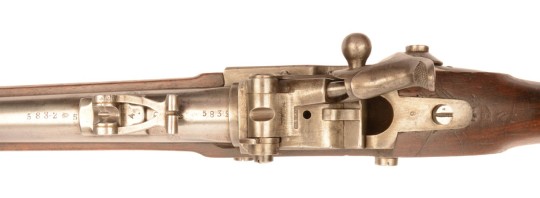
In 1863, the successor of the Hunters rifle is adopted. It’s mostly a slight upgrade of the 1856, with a longer barrel. It was built in Switzerland instead of Belgium, that is the main difference. It was of course upgraded later with the Milbank-Amsler system.

So, for the moment, we are stuck in quite a tinkering time, with quick and incremental enhancements but no real breakthrough.
Why is that ? Because once again, Europe is on the brink of war. Because of the emergency, the government buy a lot of the robust and elegant Peabody rifle from Boston, Massachusetts.


The American rifle was able to shoot 7 times a minute and was adapted to the Swiss caliber, 10.4mm. Good enough ?
Not at all. In 1866 Swiss Army tested and loved the Henry and Winchester repetition rifles. They bought 8000 rifles for test. It leads to the adoption of the Winchester/Weber-Ruech sharpshooter rifle.

So in 1867, enter the Vetterli ! It combines the Dreyse needle-rifle bolt action and the Winchester tubular magazine. It will be a hit !
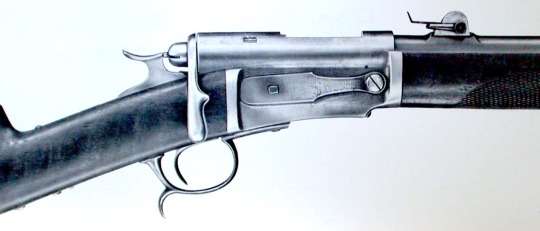
This is the first model, with the external hammer. There will be no less than 15 modifications (including carbines and short rifles) during its military career. After extensive tests it will be adopted at the 1871 rifle. It will use the famous 10.4x38R Vetterli annular percussion cartridge.
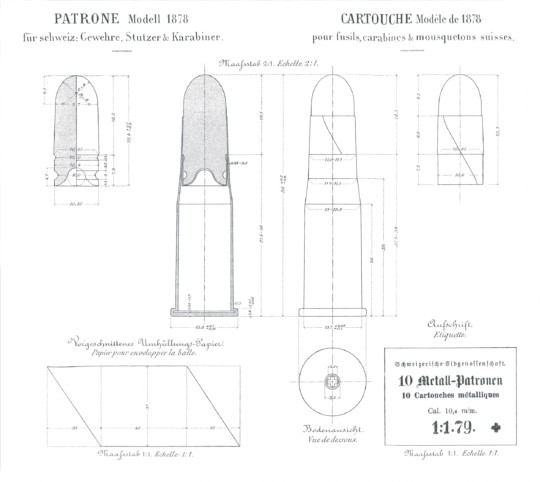
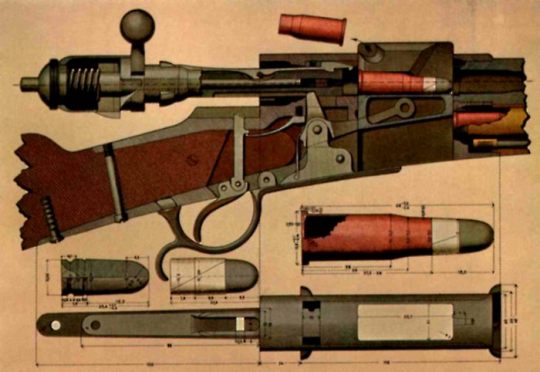

(Note the lack of external hammer on this 1869/1871 Vetterli)
Cadets got the very elegant 1870 single-shot, reduced pressure model :

Here is the 1878 variant :
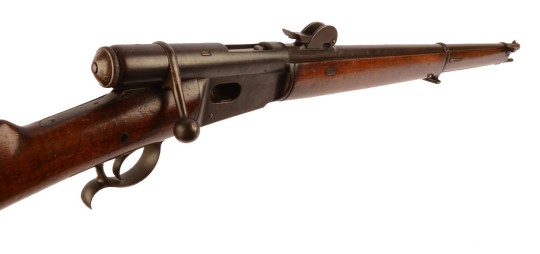
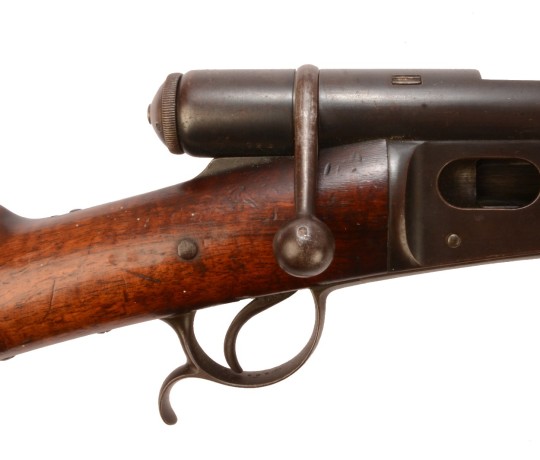

The 1878 has better protected sights, longer trigger, a curved buttstock, and one ring instead of two on the handguard. The trigger guard spur is also longer to allow a better position of the middle finger. The most important transformation was the new saw-bayonet.
The Mousqueton/Karabiner was the shortest model available, and was used by Border guards and Cavalry. Here’s the 1871/78 model :

The end of the Vetterli was caused by the introduction of smokeless powder and the development of modern cartridges like the GP90 and the GP11. The last evolution was the Border Guards short-barreled Vetterli 1878/95 that stayed in service until 1903 and the introduction of the Mq/K 1889/00. It was used in the Reserve (Landsturm) until 1911.
Note that Italian Vetterli and Vetterli-Vitali rifles were still used during WW2.
Another technological jump ? As soon as 1883, Swiss Army looked at smokeless powder cartridges. Because of its pointy tip and central percussion, the tubular magazine of the Vetterli was less than ideal to accomodate the modern 7.5x53.5mm GP 90 cartridge. Enter the 1889 Schmidt-Rubin rifle :
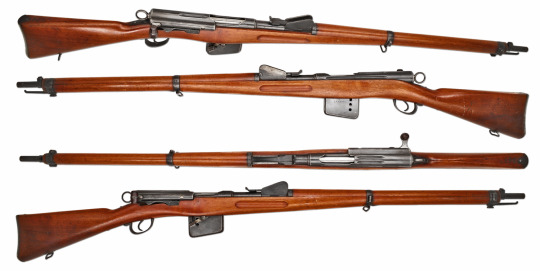
It’s long, it’s heavy, it’s accurate and it gives an edge in term of firepower to the Swiss infantryman thanks to its 12-round magazine, easily reloaded by 6-round clips and straight pull action. To give you an idea of what it was in 1889, remember the first time you saw an FN P90. It’s the Stargate tv show was set in the late XIXth Century, Richard Dean Anderson would carry a 1889 rifle over his colonial uniform. Or maybe a Winchester 1892. But probably a 1889 rifle anyway.
It was not ideal of course, and soon, the bolt was modified to put the lugs in front instead of the back, better controlling the harmonics of the mechanism by adding rigidity (providing better accuracy) and most importantly, the robustness of the bolt itself. The 1889/96 was born.

Meanwhile, the Cavalry was looking for something that wasn’t a fishing pole. They tried for a while the straigth pull action Mannlicher 1893, shooting the GP90.
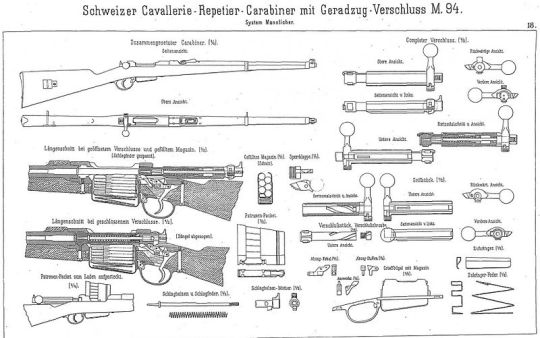

It’s probably one of the most elegant gun used in Swiss Army, but also one of the most hated, mainly because of its lack of accuracy (a capital sin in that context) and very complicated to field strip, and reassemble without destroying the bolt (!). Apparently, it was traditional to try to break these carbines by regularly hitting them. Very few survived that ordeal.
In parallel of all that, Swiss Army Cadets will be provided with the 1897 Cadet rifle, shooting both the GP 90 and a reduced load, replacing the Vetterli carbines they got until then.
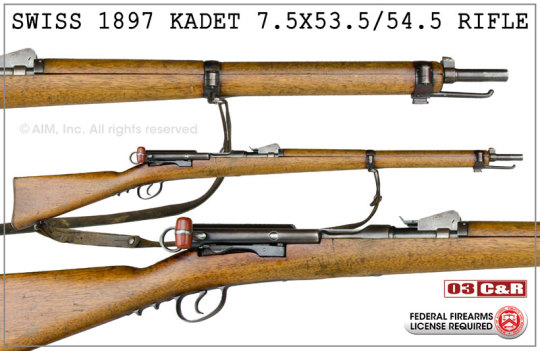
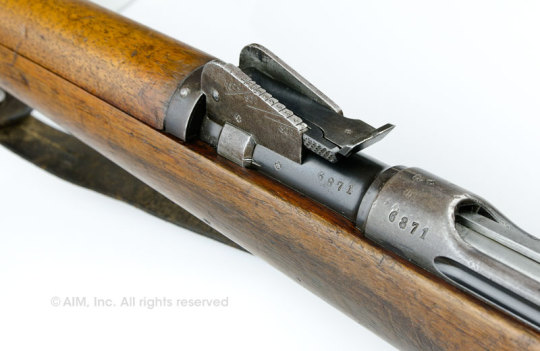
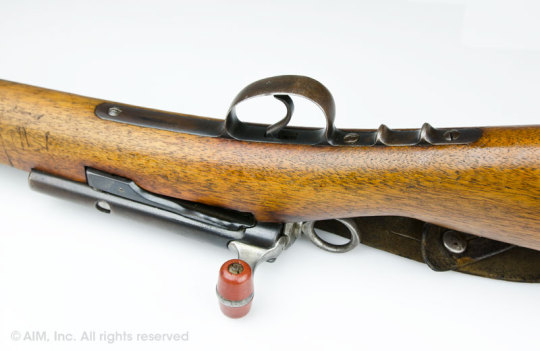
The last important variant of the 1889 rifle was the 1889/00 Short Rifle, that would give later birth to the famous Mousqueton/Karabiner:
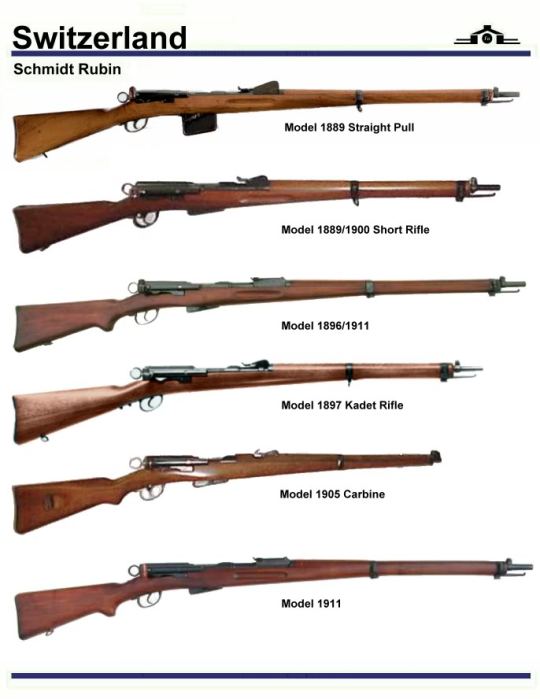
Both the 1889/00 and the 1905 Cavalry carbines shoot the GP90 cartridge and the main difference between those two is the lenght of the handguard, going to the front of the barrel for the Cavalry carbine (and preventing it to mount a bayonet).
Of course, GP90 was not enough and soon, the trials and tests of what would became the very modern GP11 began.
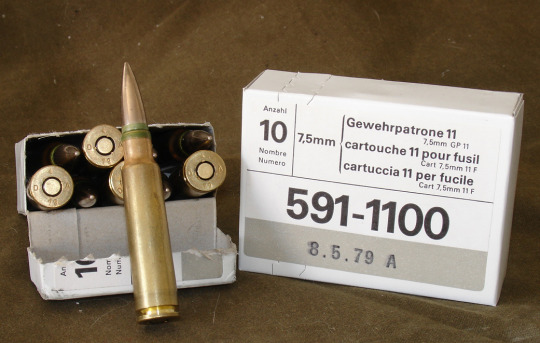
In 1908, a modernized Schmidt-Rubin rifle shooting the GP11 (7.5x55) was fielded :

Most of these test rifles were bought for cheap by Fribourg police, and the model itself was adopted as the 1911 Rifle. Its deployment will begin in the early times of WW1, and because of the war, most of the post 1896 rifles were upgraded to the 1911 standard.
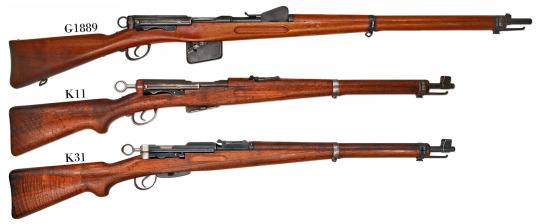
In parallel of the 1911 rifle, a shorter version was built, meant to replace both short rifles and cavalry carbines. The lessons of the trench war were also learnt since, while the rifle production was stopped at the end of the war, the carbine was built until 1933.
The problem was the Mq/K 11 was a good gun, but was lacking the accuracy standard of the 1911 rifle. Adolf Fürrer, which was the genius engineer in charge of the Waffenfabrik Bern at the times, mostly known for his toggle-action fetish and his knack to produce ugly guns, decided to enhance the old Schmidt-Rubin action. He would give us the much better Mq/K 31 - convincing the Swiss Army (and the Swiss competitive shooters) they didn’t need anymore to shoot with fish poles.

This rifle was so excellent it is still one of the best all-around weapon you can buy today. Built like a tank, fast to shoot, very reliable and accurate, powerful enough for most Septentrional game, its only fault is to not shoot a standard cartridge (I would love one in 5.56x45 !).
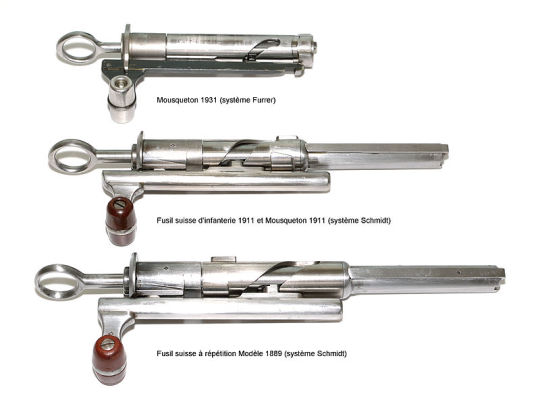

http://i.imgur.com/Bsvi4tW.gifv to see the action moving.
After that, things became a bit calmer. A lot of experimentation was made during and after the war, with all the new mechanisms emerging from Germany.
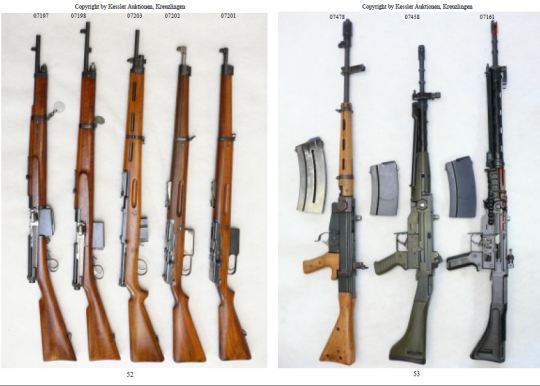
If you are interested in these, I encourage you to explore Forgottenweapons.com - they have a lot to say about them.
So, after WW2, Switzerland was on the verge of obsolescence since most of its neighbors were adopting modern semi-auto or full-auto battle rifles and assault rifles (MAS 44 in France, M1 rifle and carbine in the USA, SAFN 1949 in Belgium, SVT and Simonov, and soon after the Kalashnikov, in Soviet Russia, etc.). The need to provide the Army with a new battle rifle to replace the old Mq/K 31 was huge. The competition was between the SIG and the Waffenfabrik Bern.
SIG prototype, the AM55, was largely inspired from the Mauser STG45 and its roller-delayed locking mechanism (making it a cousin of the CETME and thus the HK G3). Sadly, they threw away everything that could have make it a great and modern rifle (especially the intermediate caliber, when Switzerland, thanks to Adolf Fuerrer studies was on the verge of adopting a true assault rifle at the end of WW1) if favor of making a huge, heavy, cumbersome rifle having all the problems of a LMG (weight) without having its advantages (sustaining a high level of suppressing fire thanks to the lack of interchangeable barrel). It was very accurate, tho.
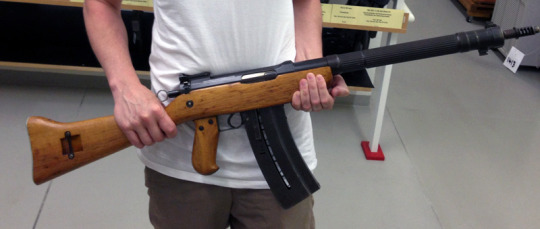
Waffenfabrik Bern was mostly inspired by the FG-42. Apparently, both guns were very similiar in performances, what made the difference was the SIG model cost half the price of the State-owned factory to make.
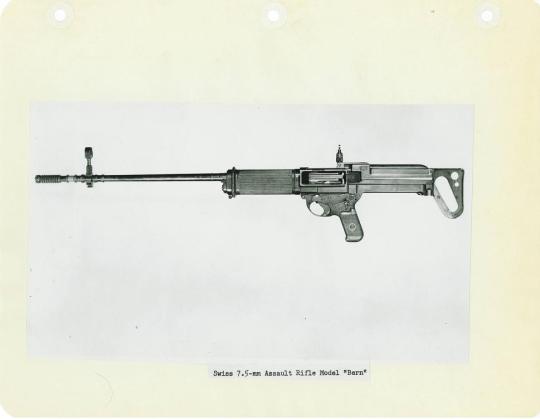
Anyway, the SIG 510 became the F ass/Stgw 57.

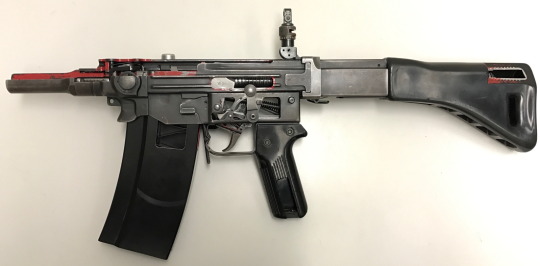

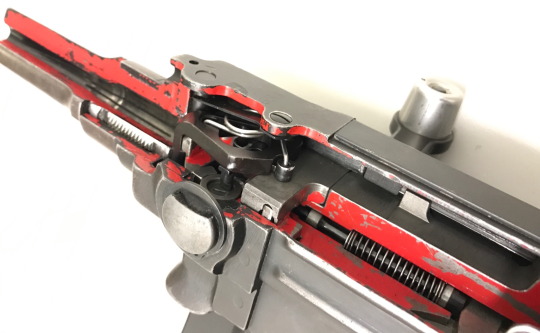
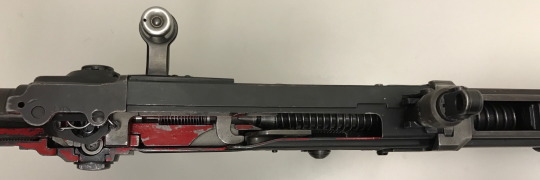

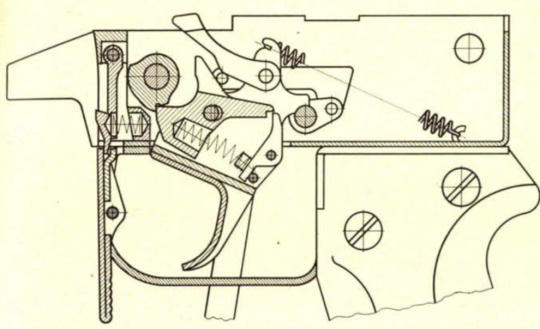
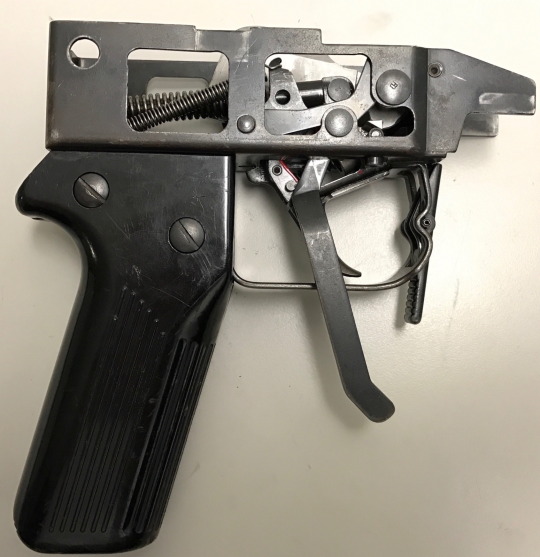
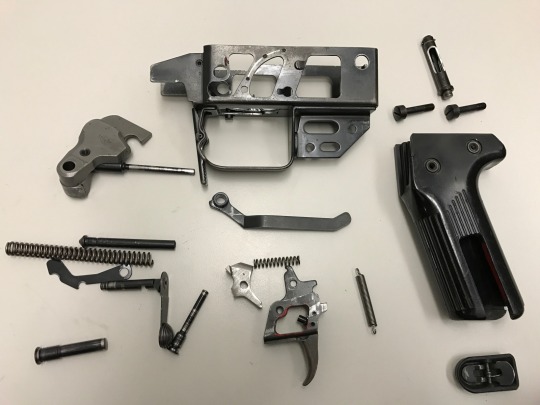
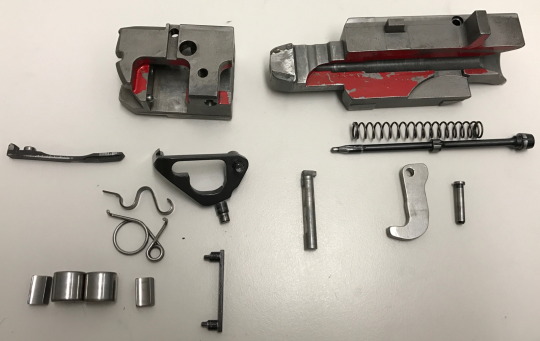
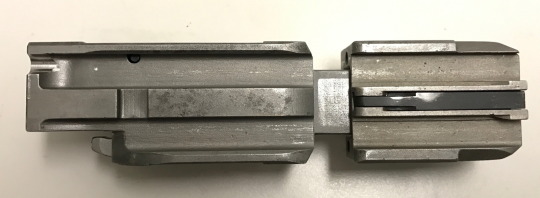

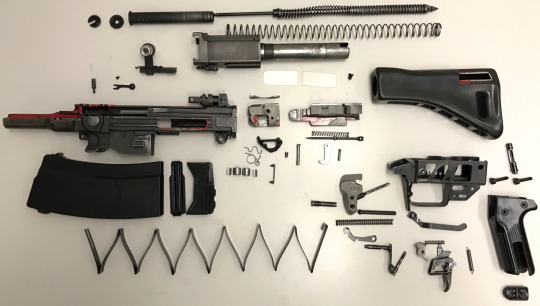
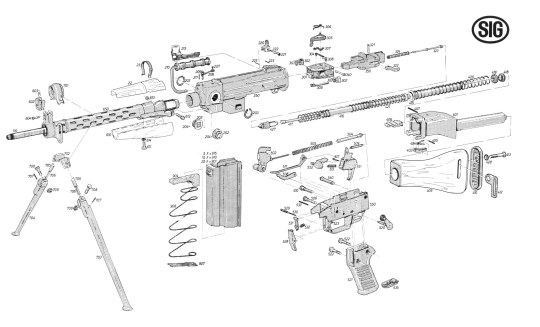
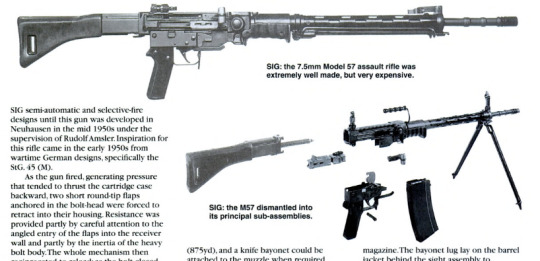

The F ass/Stgw 57 is very much a love or hate affair. I hate them with a burning rage. In my view, as a infantry rifle, it is way inferior to the Simonov, the MAS 49/56 and the FN FAL.
The last F ass/Stgw 57 were made in 1983. Once again, Waffenfabrik Bern lost the competition with its weird looking C42/E21 rifle and carbine :
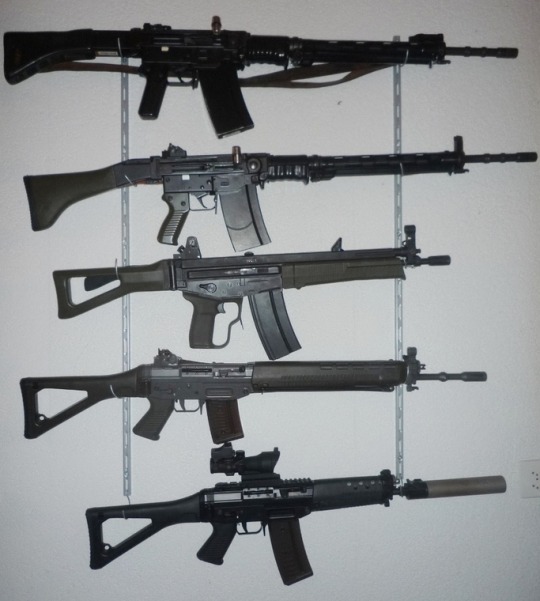
Less than 5 years later, the first F ass/Stgw 90, aka SIG 550 were deployed on the field.
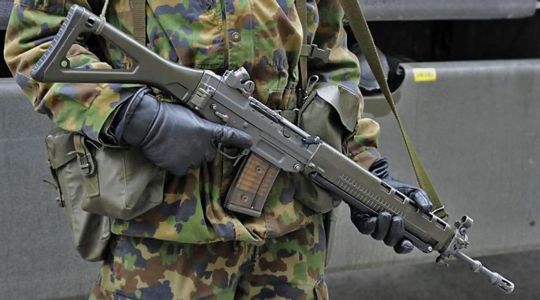
For me, this is SIG masterpiece, and the return of Swiss Army in the great light armament race.
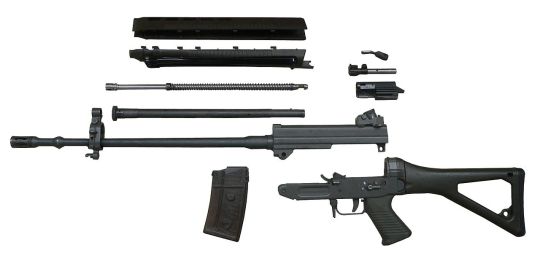
Descending from the failed SG 530 and the great SG 540 and largely inspired by the AKM mechanism, but enhanced and with great design cues from what was available in the ‘80s. It’s pretty, it’s accurate, it’s confortable to shoot (even if a bit on the heavy side), it’s simple to maintain even in the worst conditions, it’s reliable, it’s polyvalent, it’s durable…
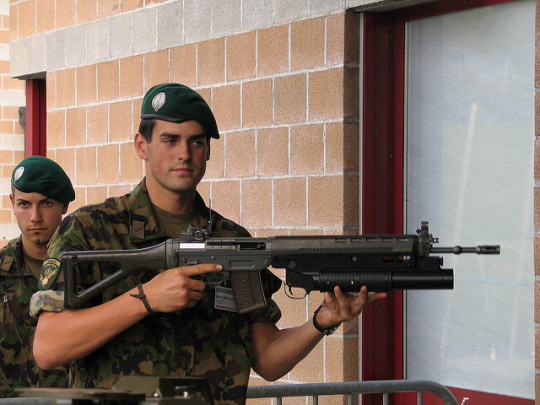
I would say without any reserve that today, it is the best rifle available on the market.




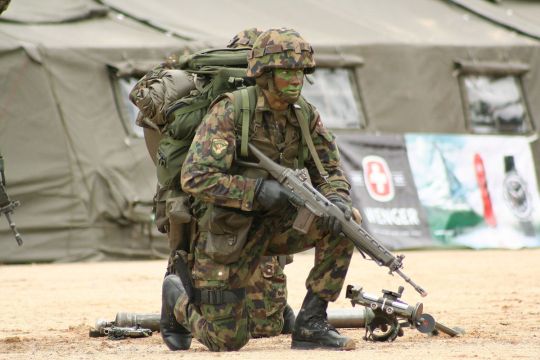
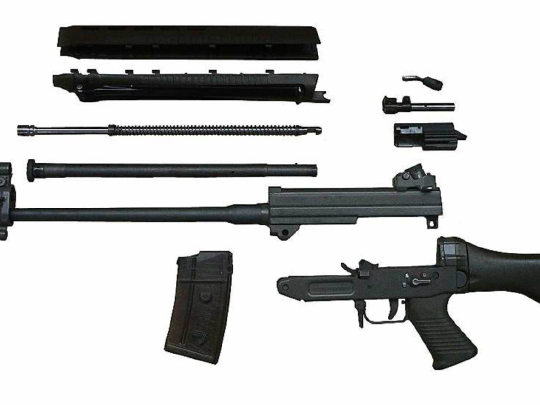
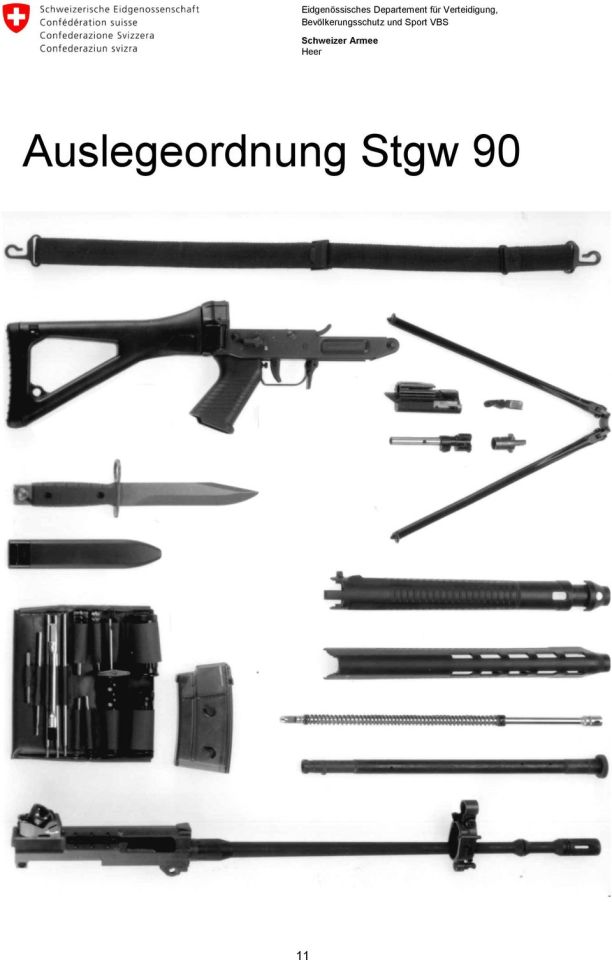
Last but not least, Swiss Army adopted for its special forces the carbine versions of the SIG 550 - first the SIG 552 as the F ass/Stgw 04 and then, when they began to kill themselves because of a stupid design error, SIG 553 and 552 upgraded to 553 standard as the F ass/Stgw 04/07.

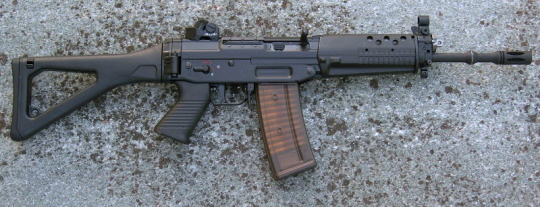
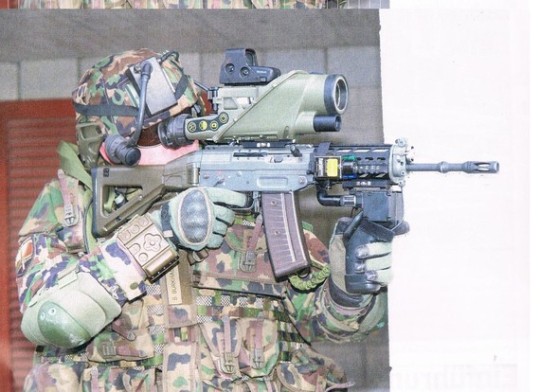
On this picture you can see the last variation that is slowly introduced on new F ass/Stgw 90, the collapsible stock.
OK, I hope I didn’t forget anything, and I didn’t write any bullshit about the antique guns. Don’t hesitate to correct me if necessary.
———————————
http://www.waffenboerse.ch/zurcher-kant-stutzer-perkussion-ca-1830.html
http://www.swissdagger.com/
http://www.loutan.net/olivier/archives/2008/01/16/fusil-dinfanterie-sig-modele-1859-armee-suisse/
http://www.fortlitroz.ch/index.php?page=t29
http://www.littlegun.info/arme%20suisse/arme%20ordonnance/a%20fusil%20infanterie%201842%20gb.htm
https://en.wikipedia.org/wiki/J%C3%A4gergewehr_1856/59
http://www.waffenboerse.ch/schweizer-ordonnanz-milbank-amsler-1863-67-10-5mm-4.html
http://collectorguns35625.yuku.com/pictures-of-my-swiss-milbank-amsler-rifle-t624.html
http://www.waffenboerse.ch/schweizer-ordonnanz-milbank-amsler-sg-1842-59-67-18mm.html
http://www.littlegun.info/arme%20suisse/ancien%20artisan/a%20milbank%20amsler%20gb.htm
https://books.google.ch/books?id=VeeiAgToOq4C&pg=PA58&lpg=PA58&dq=winchester+1866+switzerland&source=bl&ots=KqHvgOwq7x&sig=PQsebaxQKBtt0TUtNmdKiJP4tcc&hl=fr&sa=X&ved=0ahUKEwiRjvyJoLjVAhXnL8AKHUsfA-sQ6AEIPTAG#v=onepage&q=winchester%201866%20switzerland&f=false
http://www.waffenboerse.ch/schweizer-ordonnanz-vetterli-1869-71-10-4-mm.html
https://fr.wikipedia.org/wiki/Fusil_Vetterli
http://www.icollector.com/Schmidt-Rubin-1889-1896-Straight-Pull-Rifle_i13828620
http://theswissriflesdotcommessageboard.yuku.com/information-and-identification-of-96-or-11-photos–t10446.html
https://www.the-saleroom.com/en-gb/auction-catalogues/hermann-historica-ohg/catalogue-id-srher10017/lot-ef4f11e1-dc36-49ee-b9ee-a5df00fb85a2
https://www.aimsurplus.com/product.aspx?item=F3K1897KADET&name=Swiss+Model+1897+Kadet+7.5x53.5+cal&groupid=5392
http://www.swissrifles.com/sr/
http://www.littlegun.info/arme%20suisse/arme%20ordonnance/a%20fusil%20essai%201908%20fr.htm
http://imgur.com/gallery/03pBv
http://www.forgottenweapons.com/experimental-swiss-ak44/
https://laststandonzombieisland.com/2015/11/09/giant-swiss-battle-rifle-the-sig-sg-510/am55-stgw-57-prototype-at-sig-museum/
https://en.wikipedia.org/wiki/StG_45(M)
https://books.google.ch/books?id=Eq2Dnj4sDZIC&pg=PA446&lpg=PA446&dq=waffenfabrik+bern+prototype+sig+510&source=bl&ots=sdmwodMIwQ&sig=ctKS0KAfNBXTw485rIgBkaZc2Uw&hl=fr&sa=X&ved=0ahUKEwiNg9OFv7jVAhWHIMAKHXz2C3IQ6AEIWzAJ#v=onepage&q&f=false
http://theswissriflesdotcommessageboard.yuku.com/viewtopic.php?p=105740&sid=6a4187de91927c7e1a0bb92642615771#p105740
https://www.reddit.com/r/GunPorn/comments/48x6xz/stgw_57_sig_510_2400x1350oc/?st=j5uz1ty7&sh=ce573a79
http://www.swissrifles.com/sr/rlorenz/
http://www.sigarms556.com/threads/sig-550-differences-full-and-semi-auto.16146/
https://www.all4shooters.com/de/Zeitschriften/SWM-im-Web/Aktuelles/Archiv-2017/Inhalt-SWM-5-2017/
https://www.flickr.com/photos/garemilitari/3934893077/in/photostream/
26 notes
·
View notes
Text

2nd Westfälisches Husaren-Regiment Nr. 11, 1870-71
30 notes
·
View notes
Text
Rifle 101: The Difference Between Bolt, Semi-auto, Lever, and Pump Actions
For those inquiring minds who want to know the nuts and bolts differences between various rifle actions, pull up a chair and get the 411. The first muzzleloading rifles date back to at least the 17th Century. These simple single-shot black powder guns were “front stuffers,” being loaded with patch, powder, and bullet through the muzzle or front end of the gun. The name “rifle” is due to the rifling inside the barrel which imparts spin on the bullet, upping its velocity and thus increasing its accuracy and range. Rifles were far more capable when compared to smoothbore muskets and, by the 1850s, had largely replaced these older guns.
Then things started getting really interesting.
Bolt Action Rifles
Bolt-action rifles, such as this Remington 700 BDL, have been popular for well over 150 years, largely for their accuracy and ruggedness.
As breechloaders — which were loaded in the open rear of a rifle’s action rather than via the muzzle — became more common, the bolt-action rifle was not far behind. A German firearms engineer, Johann Nikolaus von Dreyse, began work on his “Needle Gun” in 1824 and the turn-bolt mechanism ushered in an era that has yet to go out of style. Bolt-action rifles, when later coupled with magazines that held extra cartridges, became king in the late 19th Century due to their accuracy and high rate of aimed fire when compared to single-shot breechloaders. Today, bolt-actions are still very popular for sport shooting, precision rifle and hunting applications for the same reasons.
Lever Action Rifles
The Marlin 336 has been in continuous production since 1948 although its basic design dates to the 19th Century. These guns, especially when chambered in .30-30, are icons when it comes to deer hunters.
Connecticut inventor Christopher Spencer in the 1860s created the basis for what today are known as lever action rifles. This downward-oriented hinged action manually works the rifle’s loading and unloading mechanism to eject spent rounds and replace them in the chamber with a fresh cartridge. Often called “Cowboy Guns” these rifles peaked in the 1890s with numerous designs from Henry, Marlin, and Winchester, many of which persist today in modernized variants. Still loved by outdoorsmen and Old West enthusiasts, the lever action is both fun to shoot and a traditional classic when it comes to rifle design.
Pump Action Rifles
The Remington 7600, chambered in a variety of popular centerfire hunting calibers, is the staple pump-action rifle and is well-liked with those used to operating shotguns with a similar action.
A concept borrowed from shotguns, the slide action or pump action rifle dates to Colt‘s circa 1885 Lightning series carbines. Described at the time as a “trombone” action, the manual sliding of the foregrip cycles the rifle’s mechanism, ejecting spent brass from the chamber and replacing it with a fresh cartridge from a fixed tubular magazine under the barrel or a box magazine under the receiver. Each backward pump kicks out a spent case, each push forward loads a new round. While rare on rifles, there are several pumps still in circulation, such as Remington’s 7600 series.
Semi-auto Rifles
The Ruger 10/22 Carbine uses a 10-shot flush-fitting magazine and produces one shot with each pull of the trigger until the magazine is empty.
The first semi-automatic rifles, which uses the energy generated through a gas or blowback mechanism to load a new cartridge from a magazine into a chamber with each round fired, popped up in the 1880s. By the early 1900s, these early “autoloaders” hit the market in the form of the Winchester Model 1903. Today, popular semi-autos, which still produce one shot with each pull of the trigger, are popular for hunting, self-defense, 3-gun competition, and target practice. While often called repeaters when first introduced, these should not be confused with full-auto or select-fire rifles which fire repeatedly with just one pull of the trigger.
Check out Guns.com for these rifle models and others, in both Certified pre-owned and new condition.
The post Rifle 101: The Difference Between Bolt, Semi-auto, Lever, and Pump Actions appeared first on Guns.com.
from Guns.com http://bit.ly/2Wwl7A9 from Blogger http://bit.ly/2Zkef62
0 notes
Text
POTD: Poppenburg’s Horizontal Sliding Action Breechloader
Back in the mid-1860s most of the world’s militaries began to clamber to adopt breech-loading systems following the success of the Prussian Dreyse Needle Rifle during the Prussian-Danish War. The Dreyse breechloader had given the Prussians a tactical advantage over the Danes who were still using muzzle-loading percussion rifle muskets. In 1865, the British Army […]
Read More …
The post POTD: Poppenburg’s Horizontal Sliding Action Breechloader appeared first on The Firearm Blog.
from The Firearm Blog http://bit.ly/2IahnO5 via IFTTT
0 notes
Text
POTD: Poppenburg’s Horizontal Sliding Action Breechloader
Back in the mid-1860s most of the world’s militaries began to clamber to adopt breech-loading systems following the success of the Prussian Dreyse Needle Rifle during the Prussian-Danish War. The Dreyse breechloader had given the Prussians a tactical advantage over the Danes who were still using muzzle-loading percussion rifle muskets. In 1865, the British Army […]
Read More …
The post POTD: Poppenburg’s Horizontal Sliding Action Breechloader appeared first on The Firearm Blog.
from The Firearm Blog http://bit.ly/2IahnO5
0 notes
Text
POTD: Poppenburg’s Horizontal Sliding Action Breechloader
Back in the mid-1860s most of the world’s militaries began to clamber to adopt breech-loading systems following the success of the Prussian Dreyse Needle Rifle during the Prussian-Danish War. The Dreyse breechloader had given the Prussians a tactical advantage over the Danes who were still using muzzle-loading percussion rifle muskets. In 1865, the British Army […]
Read More …
The post POTD: Poppenburg’s Horizontal Sliding Action Breechloader appeared first on The Firearm Blog.
from The Firearm Blog http://bit.ly/2IahnO5 via IFTTT
0 notes
Photo




The Brunswick M1860/61 needlefire pistol carbine,
The Prussian Dreyse needlefire rifle was a huge advanced in military firearms technology, and it was not long before other German states wanted it as well. The Dreyse rifle was a single shot bolt action rifle which fired a paper cartridge. It was called a needlefire rifle because the firing pin consisted of a needle which pierced the paper cartridge, igniting a primer located within the cartridge, thus discharging the round.

One of the German states which was interested in the Dreyse was the Duchy of Brunswick ( Braunschweig), who procured a number of rifles from Prussia in 1860. However, they would also created their own Dreyse design, a Dreyse bolt action pistol carbine for it’s famous cavalry forces. The carbine featured a pistol with a detachable buttstock and used the Dreyse action. With the stock attached, the carbine was around 26.5 inches in total length and weighed around 5 lbs. Thus it was a very light, compact, and handy carbine for use on horseback. Between 1861 and 1863 around 530 carbines and 100 pistol without buttstocks were produced by the Herberg Rifle Factory.
428 notes
·
View notes
Text
I want a Madsden Light Machinegun mod for Fallout 4 And a Dreyse needle rifle :^)
1 note
·
View note